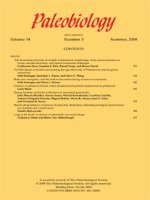A global database of gastropod sizes from the Permian through the Middle Triassic documents trends in gastropod shell size and permits tests of the suggestion that Early Triassic gastropods were everywhere unusually small. Analysis of the database shows that no specimens of unambiguous Early Triassic age larger than 2.6 cm have been reported, in contrast to common 5– 10-cm specimens of both Permian and Middle Triassic age. The loss of large gastropods is abrupt even at a fine scale of stratigraphic resolution, whereas the return of larger individuals in the Middle Triassic appears gradual when finely resolved. Taphonomic and sampling biases do not adequately explain the absence of large Early Triassic gastropods. Examination of size trends by genus demonstrates that the size decrease across the Permian/Triassic boundary is compatible with both size-selective extinction at the species level and anagenetic size change within lineages. Size increase in the Middle Triassic resulted from the origination of large species within genera that have Early Triassic fossil records and the occurrence of new genera containing large species during the Middle Triassic. Genera recorded from the Permian and Middle Triassic but not the Early Triassic (“Lazarus taxa”) do not contribute to observed size increase in the Middle Triassic. Moreover, Lazarus taxa lack large species and exhibit low species richness during both the Permian and the Middle Triassic, suggesting that they survived as small, rare forms rather than existing at large sizes in Early Triassic refugia. The ecological opportunities and selective pressures that produced large gastropods during most intervals of the Phanerozoic evidently did not operate in Early Triassic oceans. Whether this reflects low predation or competitive pressure, r-selection facilitated by high primary production, or physical barriers to large size remains poorly understood.
How to translate text using browser tools
1 June 2005
Evolutionary dynamics of gastropod size across the end-Permian extinction and through the Triassic recovery interval
Jonathan L. Payne
ACCESS THE FULL ARTICLE





